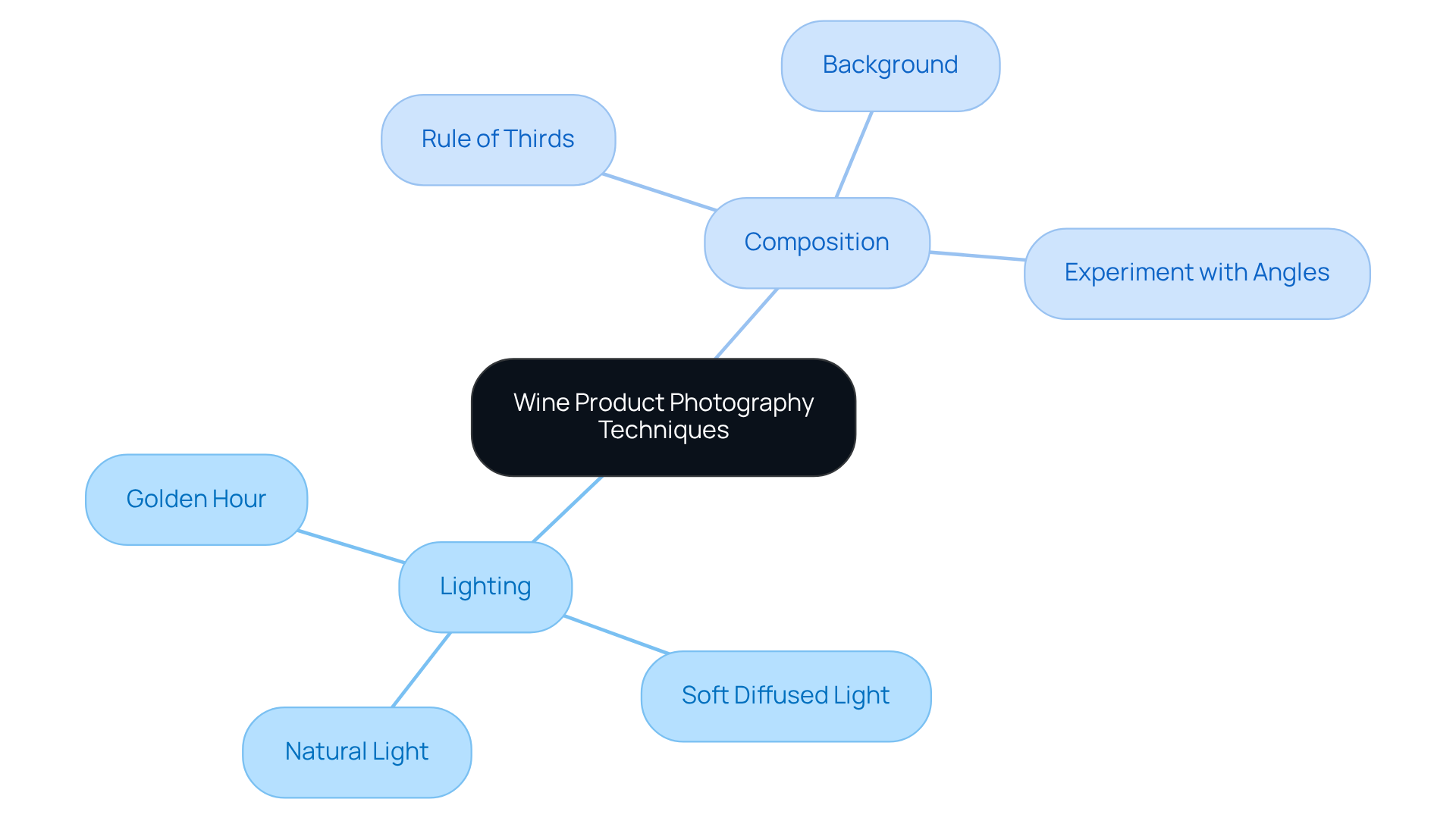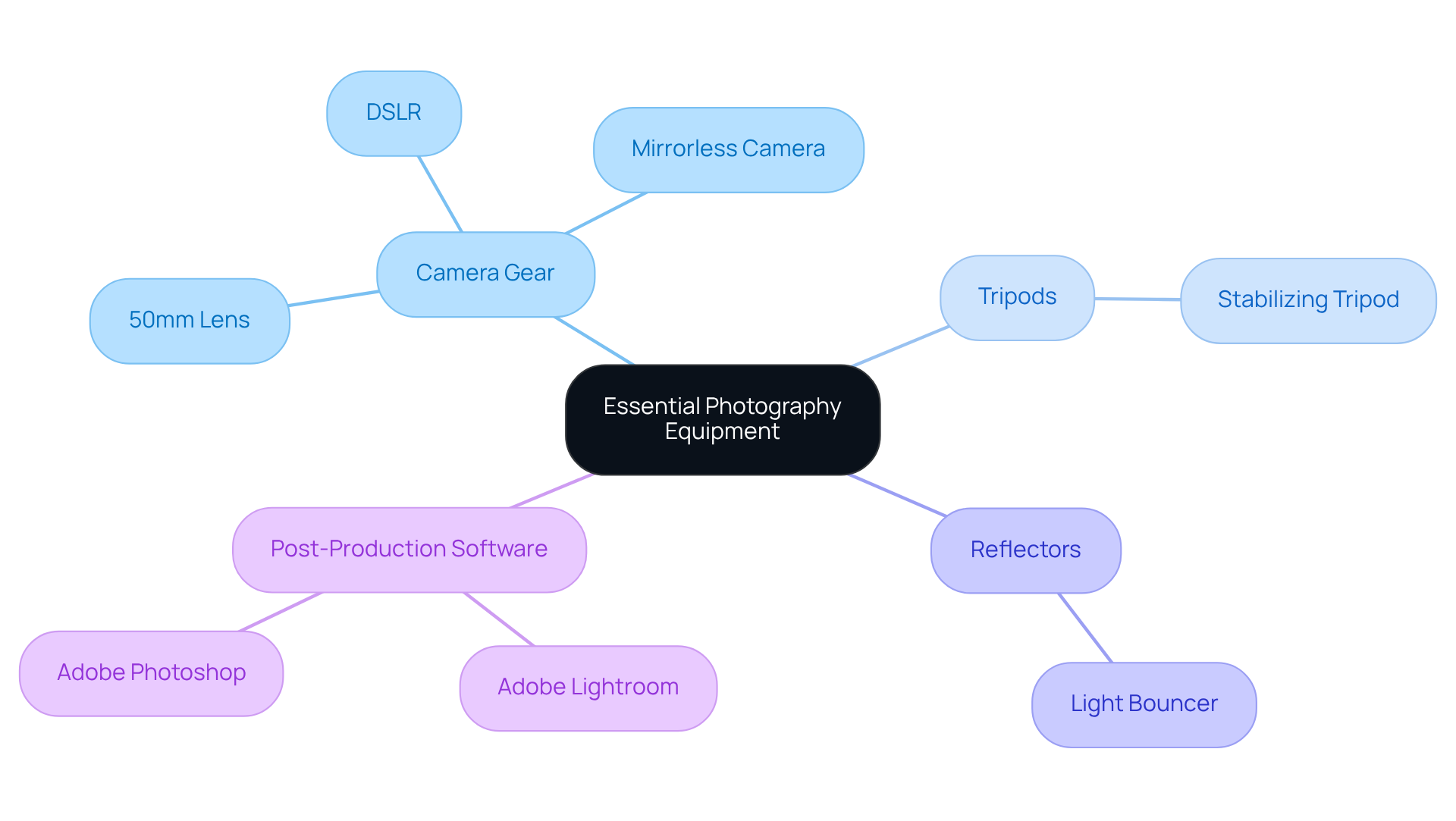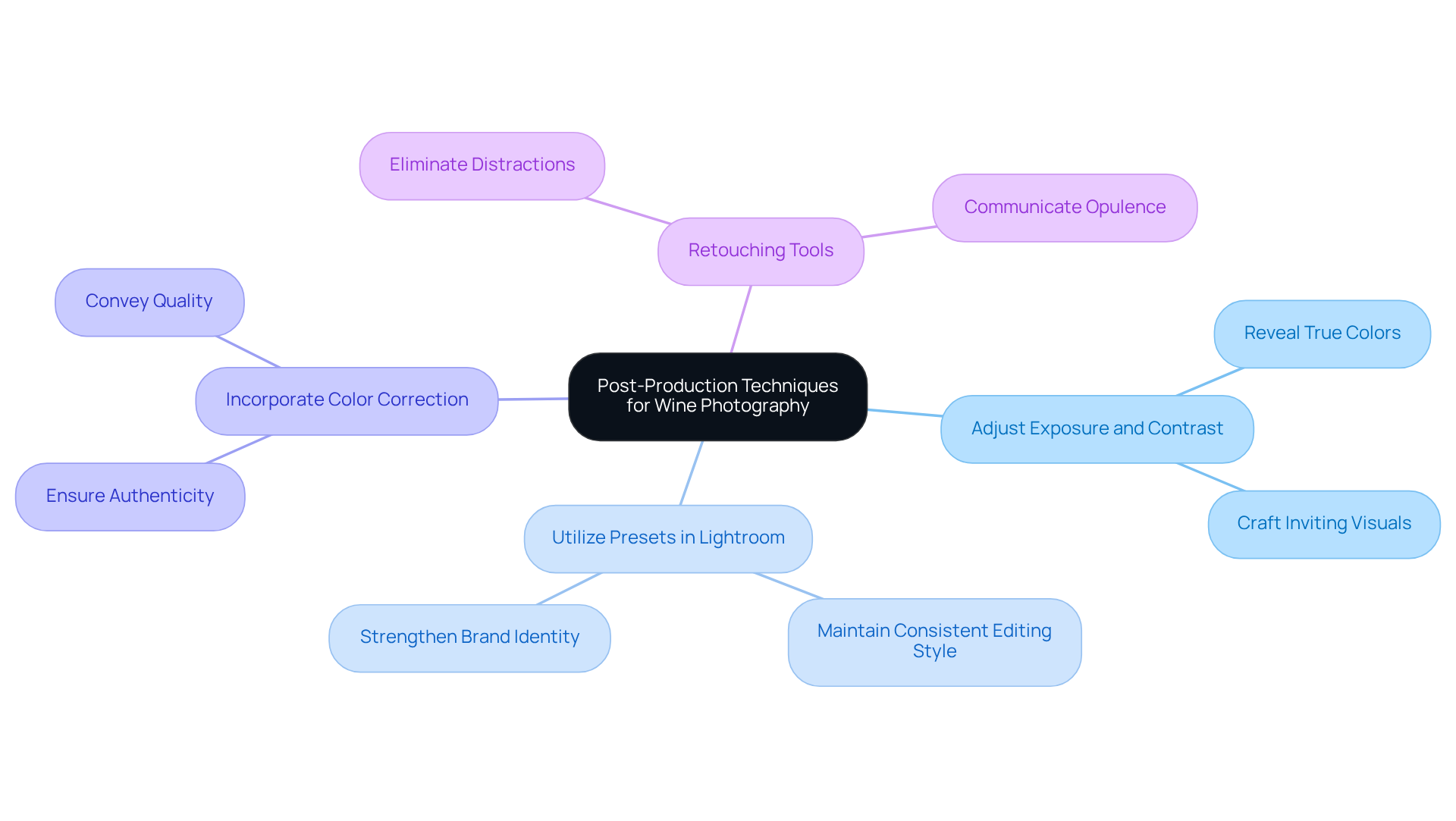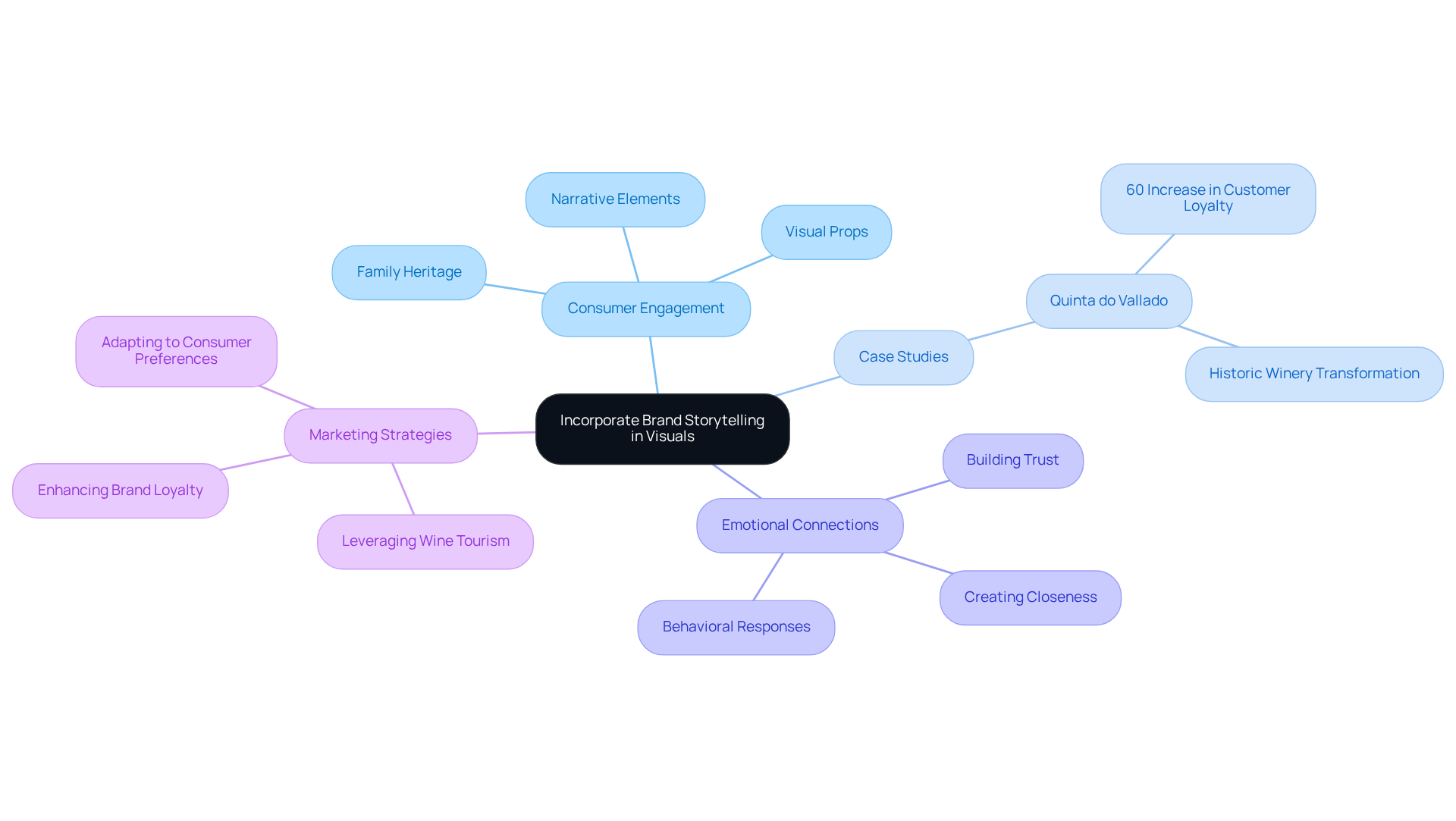Overview
Mastering the art of stunning wine product photography is essential for capturing consumer attention and driving sales. Key practices include:
- Mastering lighting and composition
- Selecting essential equipment
- Employing effective post-production techniques
- Weaving brand storytelling into visuals
Techniques such as:
- Using natural light
- Adhering to the rule of thirds
- Utilizing quality cameras and editing software
are not merely suggestions; they are proven strategies that can significantly enhance the visual appeal and consumer engagement of wine products. Real-world examples illustrate how these methods have led to increased sales and strengthened brand loyalty, demonstrating their undeniable impact. By implementing these best practices, wine marketers can elevate their visual storytelling and ultimately achieve greater success in a competitive marketplace.
Introduction
Capturing the allure of wine through photography is not merely an art; it is a sophisticated blend of technical skill and a profound understanding of storytelling. In an increasingly visual beverage industry, mastering the nuances of wine product photography can dramatically enhance a brand's presence and consumer engagement.
But how does one elevate a simple bottle into a captivating image that resonates with potential buyers? This article delves into four essential best practices that not only amplify the aesthetic appeal of wine photography but also craft compelling narratives that forge connections with audiences, ensuring that every shot tells a story worth sharing.
Master Lighting and Composition Techniques
To achieve stunning wine product photography, mastering lighting and composition is crucial. Natural light frequently emerges as the optimal choice for capturing the true essence of any beverage. Aim for soft, diffused light, particularly during golden hour—the hour after sunrise or before sunset. This type of lighting minimizes harsh shadows and accentuates the beverage's color and clarity.
In terms of composition, adhere to the rule of thirds:
- Divide your frame into a 3x3 grid.
- Position the bottle or glass along these lines or at their intersections.
This technique cultivates a balanced and engaging image. Moreover, consider the background; a simple, uncluttered backdrop is essential for effective wine product photography as it allows the wine to stand out. Experiment with angles—shooting from above or at eye level can provide unique perspectives that enhance the visual appeal of the item.
A real-world example illustrates this point effectively: a winery that employed natural lighting and the rule of thirds in their promotional imagery experienced a 30% increase in engagement on their social media platforms. This outcome underscores the effectiveness of these techniques, encouraging you to apply them in your own photography endeavors.

Select Essential Photography Equipment
When it comes to enhancing your beverage images for wine product photography, having the right camera gear is indispensable. A DSLR or mirrorless camera paired with a quality lens is fundamental; a 50mm lens is particularly recommended for its versatility and its ability to produce stunning bokeh—the aesthetic quality of the blur in out-of-focus areas.
Moreover, a tripod is vital for stabilizing your shots, especially in low-light situations. Utilizing reflectors can significantly improve your images by bouncing light onto the bottle, accentuating its features while avoiding harsh shadows.
In the realm of post-production, software such as Adobe Lightroom or Photoshop can refine your images effectively. However, it is essential to start with high-quality captures to ensure the best results.
Consider this real-world example: A family-owned winery that upgraded to a DSLR camera and invested in a quality lens reported a remarkable 50% increase in online sales after enhancing their wine product photography. This showcases the direct impact of utilizing the right equipment, urging you to .

Utilize Effective Post-Production Techniques
Post-production techniques are essential for enhancing wine product photography. Begin by adjusting exposure, contrast, and saturation to ensure the beverage's color is both vibrant and accurately represented. Cropping can further enhance composition, directing the viewer's focus squarely on the product.
- Adjust Exposure and Contrast: Fine-tuning exposure and contrast is crucial for revealing the wine's true colors. This step is vital for in wine product photography that captures attention.
- Utilize Presets in Lightroom: Employing presets in Lightroom is an effective strategy for maintaining a consistent editing style across your images, which is critical for identity recognition. Consistency in editing not only strengthens brand identity but also weaves a unified visual narrative that resonates with consumers. As Jill Barth observes, "In the dynamic realm of beverage marketing, keeping up with photography trends is vital for developing a captivating brand presence."
- Incorporate Color Correction: Attention to color correction is necessary to ensure that the beverage appears as it does in reality. This accuracy is particularly important for conveying authenticity and quality.
- Retouching Tools: Leverage retouching tools to eliminate distractions or flaws, ensuring a polished final outcome. Rich hues and intricate perspectives in wine product photography can communicate opulence and elegance, appealing to consumers of premium beverage labels.
Consider the case of a winery that adopted a consistent editing style across its product images, resulting in an impressive 40% increase in brand awareness. This example underscores the substantial impact that meticulous post-production can have on enhancing overall product perception and consumer engagement, aligning with broader trends in beverage marketing that highlight the importance of visual storytelling.

Incorporate Brand Storytelling in Visuals
Integrating brand storytelling into wine product photography significantly enhances consumer engagement, particularly for family-owned wineries striving to thrive in a competitive market. Each beverage carries a unique narrative—its origin, the winemaking process, or the family heritage—which must be vividly reflected in the visuals. For instance, when showcasing a wine produced from grapes grown in a historic vineyard, it is essential to include elements of that vineyard in the background or utilize props that evoke its rich history. This strategy not only emphasizes the product but also fosters a between consumers and the company's narrative, ultimately [transforming casual buyers into loyal club members](https://blog.enocap.com/10-wine-marketing-companies-transforming-your-winerys-success).
A compelling case study is Quinta do Vallado, which highlighted its family legacy through its photography, resulting in a remarkable 60% increase in customer loyalty. This demonstrates how powerful storytelling can forge lasting connections with consumers, deepening their emotional commitment to the company. Furthermore, research indicates that storytelling in visuals, such as wine product photography, can stimulate positive feelings and cultivate brand loyalty, making it an essential component of modern wine marketing strategies. By weaving narratives into product images, wineries can engage consumers on a more profound level, driving consistent growth and securing the necessary capital for future opportunities.

Conclusion
Mastering wine product photography is essential for creating compelling visuals that resonate with consumers and elevate your brand's presence in a competitive market. This endeavor requires a blend of technical skills and creative storytelling. By focusing on:
- Lighting
- Composition
- Essential equipment
- Post-production techniques
- Brand storytelling
photographers can produce stunning images that capture the essence of the wine while engaging consumers on a deeper level.
Key practices highlighted in this article include:
- Harnessing natural light for beautiful clarity
- Employing the rule of thirds for balanced composition
- Selecting the right equipment to enhance image quality
Additionally, effective post-production techniques such as color correction and consistent editing styles are crucial for enhancing visual appeal and brand identity. Weaving storytelling elements into photography can significantly strengthen consumer connections and loyalty, as evidenced by successful case studies.
Incorporating these best practices into wine product photography not only enhances the aesthetic quality of images but also serves as a powerful marketing tool. As the wine industry evolves, leveraging these techniques can create compelling visuals that drive engagement and sales. Embrace the art of wine photography and transform your visuals into captivating narratives that elevate your brand's presence.
Frequently Asked Questions
Why is lighting important in wine product photography?
Lighting is crucial because it helps capture the true essence of the beverage. Natural light, particularly soft, diffused light during golden hour, minimizes harsh shadows and enhances the wine's color and clarity.
What is the best time to take wine product photographs using natural light?
The best time to take photographs is during golden hour, which is the hour after sunrise or before sunset.
What is the rule of thirds in photography?
The rule of thirds involves dividing the frame into a 3x3 grid and positioning the bottle or glass along these lines or at their intersections to create a balanced and engaging image.
How should the background be arranged in wine product photography?
The background should be simple and uncluttered to allow the wine to stand out effectively.
What angles can be experimented with in wine product photography?
Angles such as shooting from above or at eye level can provide unique perspectives that enhance the visual appeal of the wine.
Can you provide an example of the effectiveness of these techniques?
A winery that used natural lighting and the rule of thirds in their promotional imagery saw a 30% increase in engagement on their social media platforms, illustrating the effectiveness of these techniques.




